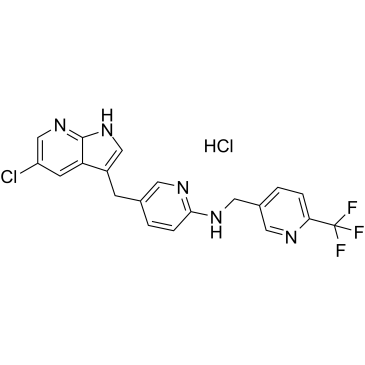Pexidartinib hydrochloride (PLX-3397)
Modify Date: 2025-08-26 16:57:16

Pexidartinib hydrochloride (PLX-3397) structure
|
Common Name | Pexidartinib hydrochloride (PLX-3397) | ||
|---|---|---|---|---|
| CAS Number | 2040295-03-0 | Molecular Weight | 454.28 | |
| Density | N/A | Boiling Point | N/A | |
| Molecular Formula | C20H16Cl2F3N5 | Melting Point | N/A | |
| MSDS | N/A | Flash Point | N/A | |
Use of Pexidartinib hydrochloride (PLX-3397)Pexidartinib hydrochloride (PLX-3397 hydrochloride) is a potent, selective and ATP-competitive CSF1R (cFMS) and c-Kit inhibitor, with IC50s of 20 and 10 nM, respectively. Pexidartinib exhibits 10- to 100-fold selectivity for c-Kit and CSF1R over other related kinases, such as FLT3, KDR (VEGFR2), LCK, FLT1 (VEGFR1) and NTRK3 (TRKC), with IC50s of 160, 350, 860, 880, and 890 nM, respectively[1]. |
| Name | Pexidartinib hydrochloride |
|---|
| Description | Pexidartinib hydrochloride (PLX-3397 hydrochloride) is a potent, selective and ATP-competitive CSF1R (cFMS) and c-Kit inhibitor, with IC50s of 20 and 10 nM, respectively. Pexidartinib exhibits 10- to 100-fold selectivity for c-Kit and CSF1R over other related kinases, such as FLT3, KDR (VEGFR2), LCK, FLT1 (VEGFR1) and NTRK3 (TRKC), with IC50s of 160, 350, 860, 880, and 890 nM, respectively[1]. |
|---|---|
| Related Catalog | |
| Target |
IC50: 10 nM (c-Kit), 20 nM (cFMS), 160 nM (FLT3), 350 nM (KDR), 860 nM (LCK), 880 nM (FLT1), 890 nM (NTRK3)[1] |
| In Vivo | Pexidartinib (PLX3397; 0.25, 1 mg/kg, i.p., twice daily for 8 days) inhibits the proliferation of microglia and BrdU-positive cells in neonatal mice[2]. Pexidartinib (1 mg/kg, twice daily for 8 day) shows no obvious effect on the cleaved caspase-3-positive cells in mice[2]. Animal Model: Neonatal mice[2] Dosage: 0.25, 1 mg/kg Administration: I.P. twice daily for 8 days Result: Decreased the number of microglia and BrdU-positive proliferative cells, but did not change the cleaved caspase-3-positive cells. |
| References |
| Molecular Formula | C20H16Cl2F3N5 |
|---|---|
| Molecular Weight | 454.28 |
| Storage condition | 2-8℃ |